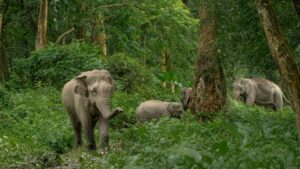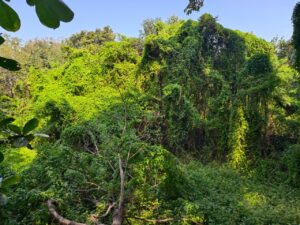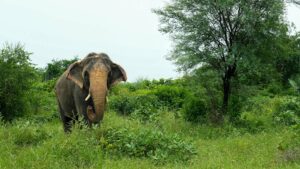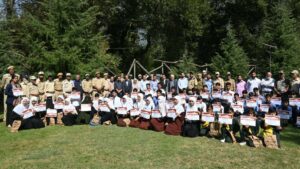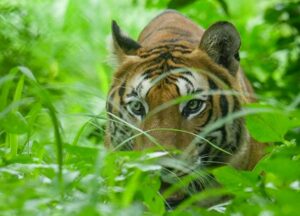Growing up, quite a few of us might have witnessed our parents or grandparents tending to the little makeshift garden they were nurturing in the balcony. The potted rose plants, marigolds, or even succulent aloevera grew lushly as sunlight poured in abundance. But except for these, do you perchance remember the names of other green leafy plants that accompanied these known ones? Or the name of the little chirper that would sweetly sing every morning outside your windows?
We often marvel at the rich flora and fauna present in faraway lands, but what about the wildlife that shares our own landscapes? Everyone knows the national animal or national flower of India. But if we were to ask a room full of people what their state animal or bird is, we’ll often be met with guesses — or silence. And it’s not because they don’t care. Most people do care. They just don’t know. At Wildlife SOS, we’ve found that the real problem isn’t apathy. It’s the lack of awareness. That is something we can change and that’s what we have been doing consistently through our numerous awareness campaigns, programmes and workshops.

Every wild animal plays a role in the balance of nature and when conflict pushes them to the edge, Wildlife SOS steps in to offer not just rescue, but a second chance at life. [Photo © Wildlife SOS]
In regions like Jammu & Kashmir (J&K), the Himalayas are home to more than snow and cedar trees. Leopards roam its forests, and both Asiatic black bears and Himalayan brown bears forage in the hills. But with habitat loss, shifting climates, and food scarcity, wild animals often wander into human settlements. That’s where things go wrong.
Imagine, it’s early morning in a village near the forest. A farmer wakes to find his poultry coop completely wrecked. The culprit? A bear. Or was it a leopard? Or maybe some other wild, unexpected visitor. In panic and fear, he doesn’t wait for answers, he, like the majority of people, lashes out — not just at the animals, but at the very idea of coexisting with them.

Villagers move cautiously through fields near the forest edge as fear and frustration often lead several deadly attempts to chase away wild animals seen as threats to their livelihoods. [Photo © Wildlife SOS]
Back in 2006, Wildlife SOS began small awareness meetings with local communities in J&K. It started with just a few people that were curious, cautious, and scared. While they have been surrounded by wildlife for generations, they didn’t really know how to live with wildlife in close proximity. We were stunned by the local myths that had gripped the people in fear — “leopards suck blood” or “bears eat humans”. Stories of wild animals ‘killing’ villagers spread fast, but no one was really asking why it happened, or what triggered the encounter.
So, we dug deeper. We did year-long surveys. We studied animal behaviour and movement patterns and found that early mornings and late evenings were prime leopard hunting times. We brought this information back to the people. Slowly, with awareness and empathy, we started busting the myths.

Sessions such as the herpetology workshop held in Delhi last year help in shifting perceptions — participants not only learn how to identify snakes through non- venomous snakes handled under expert supervision , but also understand their vital ecological roles. [Photo © Wildlife SOS/Kunal Malhotra]
One of our key findings during this time was startling — most villagers believed wildlife were a nuisance, and the only solution was to kill them. Tolerance was at an all-time low. But here’s a powerful truth: when knowledge increases, behaviour changes, and with it, attitudes.
We guided communities about body language — both by humans and animals. We explained what not to do if you see a bear or leopard (run, for example) and what to do instead (stay calm, back away slowly). We helped people understand the reason behind crop raids, or why a leopard might target livestock near poultry farms. Then came our efforts to bridge the gap between the people and the local government towards one cause. We got local government officials, village heads, and community leaders together — people who often worked in silos, unaware of each other’s efforts. Suddenly, they knew their constitutional rights. Compensation schemes became clear because of the Payment of Compensation to Victims of Attack by Wild Animals Act, 2022, which is applicable to the entirety of India. With growing awareness, reporting systems naturally improved in a brighter direction.

With the frequency of a leopard being spotted near human homes in Maharashtra, Wildlife SOS distributed pamphlets of guidelines on how to safely handle such encounters. [Photo © Wildlife SOS]
Before this, people would ask for a gun to protect themselves against the wild. Now, they have taken to calling our rescue helpline to report wildlife sightings. Now, as many as 10 to 12 calls on our rescue helpline in J&K are received in a single day that involve our professional intervention. We have managed to build trust in them. It took time and conflict is still ongoing. But we see the change, and it began with the singular mission of spreading awareness.
National Awareness: The Bigger Picture
Now let’s look at the national level. India is a biodiversity powerhouse—but how much do we really know about what we’re trying to save? Do weFor many species, we don’t even have any population baselines to maintain a basic guide.Climate change is already rewriting their behaviour: their sleeping patterns, hunting patterns, migration patterns. The data on these which held true 10 years ago may not hold today because of the rapid change of the earth’s ecosystem. Rainfall patterns have shifted. Forest cover has thinned out. And the animals either continue to adapt, or are on the brink of perishing.

Wildlife SOS field team engaging with a mixed group of national and international volunteers, busting myths and replacing their fear with facts. [Photo © Wildlife SOS]
This means we need ongoing research, not just old data. And for that, we need funding, resources, and, crucially — interest. People won’t fund what they don’t understand. And again, that circles back to awareness.
Wildlife SOS often holds sessions at schools, colleges, and universities but in the early days, most institutes weren’t exactly queuing up to listen. Conservation sounded like a far-fetched topic from the West with no relevance in the Indian landscape. But today, it’s different. As awareness takes root and conversations about conservation, sustainability and responsibility become the need of the hour, institutions reach out to us. They now want lectures, workshops, even a chance to volunteer to help the seed of conservation grow.

Students take a stimulating nature walk with Wildlife SOS educator during a school awareness session — asking sharp, thoughtful questions [Photo © Wildlife SOS ]
We’ve seen World Environment Day go from being a checkbox event to a genuine celebration. Students visit our rescue centres, ask thoughtful questions, and return eager to know more. They’re curious about bear diets and are taken aback that some enjoy eating fruit and grass! They are especially intrigued by species we rescue like snakes and other reptiles.
Our education model is simple but powerful: start with what’s local. Ask a class of school children what their state bird or animal is or the names of the flowers in their balconies. That’s how one begins to build a relationship with the nature around them. By the second session, they’re back with research and interesting questions of their own. That’s what we call progress.

Conservation is no longer a niche — it’s a global concern, and when volunteers witness the transformation of an animal they’ve helped care for, the cause becomes personal, relatable, and lasting. [Photo © Wildlife SOS]
We also run group tours, workshops, clean-up drives at our Bannerghatta Bear Rescue Centre (BBRC), and invite volunteers to participate in making enrichments for the bears at Agra Bear Rescue Facility (ABRF) and witness the majestic elephants under our care at the Elephant Conservation and Care Centre (ECCC). Nothing beats watching how a sloth bear or elephant saved from distress conduct their daily activities in a safe and nourishing environment.
Collective Collaboration: The Key to Lasting Change
Conservation requires teamwork across communities, governments, NGOs, and especially forest officials on the frontlines. Wildlife SOS works closely with forest departments nationwide, including through our Manikdoh Leopard Rescue Centre (MLRC) in Maharashtra, where we conduct specialised training workshops for forest guards and officers.
Through CSR partnerships, training programmes and outreach events, we help them channel resources where they’re needed most. That’s why we always put our best foot forward. We tailor our messaging according to the audience, in the manner that would resonate with them the most. We explain what we do, how long it takes, and why it matters — because the general public is often unaware of the unfortunate plight of captive or injured animals.

Not every meeting yields immediate results; sometimes we simply talk, listen, and connect, knowing that today’s conversation could spark tomorrow’s collaboration. [Photo © Wildlife SOS]
These sessions cover essential rescue techniques, equipment handling, and animal care to prepare officials to respond effectively and compassionately to human-wildlife conflicts and emergencies. By sharing 30 years of experience, Wildlife SOS helps strengthen local capacity to protect wildlife and promote coexistence.
Beyond skills, we foster ongoing dialogue and partnerships because tackling challenges like habitat loss and climate change needs collective effort. Through training and collaboration at centres like MLRC, BBRC, and ABRF, Wildlife SOS supports forest officials in safeguarding both animals and communities for a sustainable future.

When we cite experiences and share knowledge gained in the past 30 years, we help participants attending our awareness programmes see not just what’s happening, but why. [Photo © Wildlife SOS/ Akash Dolas]
The challenges may vary, but the themes are universal: habitat loss, conflict, climate change. Whether it’s elephants in India or wolves in Europe, conservation is a global conversation. Conservation knows no borders. And neither does awareness.
Facing the Challenges — And Tackling Them With Heart
Working in conflict zones or rural areas isn’t easy. People are scared, and angry after suffering loss. You can’t walk in with an agenda. You walk in with empathy. That’s exactly what our Co-founders Mr. Kartik Satyanaryan and Ms. Geeta Seshmani did at the start of the ‘Dancing’ Bear Project. They didn’t just rescue the sloth bears; they stayed, listened, and understood the pain and poverty behind the practice.
Simply taking the bears away would have left the Kalandar community that was conducting this practice for over four centuries with nothing, and could lead them back towards abducting another unsuspecting bear cub. Instead, Wildlife SOS helped them rebuild their lives with dignity, through education, livelihood support, matrimonial support, and a future free from exploitation. And today, more than 5,000 Kalandar families have found sustainable careers through Wildlife SOS Tribal Rehabilitation Programme.

We didn’t just rescue the ‘dancing’ sloth bears— we stood by the Kalandar community that monetarily relied on this practice, understood their struggles, and helped them build a new path forward. [Photo © Wildlife SOS/ Suryoday Singh ]
When it comes to performing rescues in cities, our field teams execute operations not just with professional expertise, but through conversation with concerned people as well. And storytelling. Always storytelling. Because long lectures fade. But one sloth bear’s rescue? One elephant’s journey? That stays.
Awareness isn’t an add-on. It’s the beginning. So if you’ve ever felt like you didn’t know enough — you’re not alone. But, you can change that. Visit and volunteer at our centres. Share your experiences with friends and family. Because the first step to saving wildlife is simply noticing it. And once you notice, it’s hard to look away.
Awareness begins with reading, questioning, and engaging. And maybe next time someone asks what your state bird is… you’ll know.
And if not, we’ll be right here — knocking again.
Feature image:Hemanta Bijoy Chakma/ Wildlife SOS


